This post has not been edited by the GamesBeat staff. Opinions by GamesBeat community writers do not necessarily reflect those of the staff.
Hey there guys and gals and welcome to yet another review. Tonight I am going to take you all on an epic voyage across the high seas of Hyrule (well technically the Great Sea above Hyrule) as my little way of celebrating the 25th Anniversary of The Legend of Zelda franchise. And no, this isn’t a review of Wind Waker. But that’s not a bad guess, as this is the sequel to the Game Cube classic. This is The Legend of Zelda: The Phantom Hourglass for the Nintendo DS.
That’s right, for the few of you who don’t know, that installment (originally released in 2003) which was both loved and hated by fans (more on that later) received a sequel back in 2007 on the now previous generation handheld, the Nintendo DS and was given a bold control scheme that was a series first.
Is this portable sequel worth a few grains of time? Or does it set sail for fail?
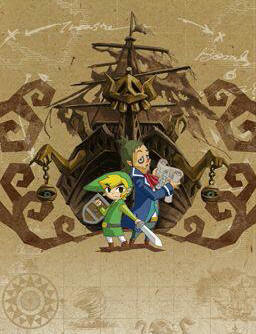
After defeating the evil lord Ganondorf in the depths of the underwater world of Hyrule, Link and the newly rescued Tetra (A.K.A. Princess Zelda), set sail for a life of excitement and adventure as pirates on the Great Sea. However, their journey doesn’t prove to be smooth sailing, as they encounter the mysterious Ghost Ship, which has been abducting any travelers who dare steer too close. Tetra (of course) decides that the best thing to do is to board the ship and investigate but she gets taken prisoner and Link falls into the ocean during his attempt to save her.
Link washes up on the shore of Mercay Island and is found by a fairy named Ciela. After exchanging pleasantries, Link explains his current predicament involving Tetra and the Ghost Ship. Ciela suggests paying a visit to her grandfather Oshus, who happens to know everything there is to know about the evil vessel. Oh and he’s also human? I could tell you who he and Ciela really are but that would spoil the fun of discovery.
Oshus gives Link a sword and tells him that he must search the four seas in order to find the Ghost Ship. But to do that, he’ll have to enter the Temple of the Ocean King (*Annoyed Grunt* a reflection of things to come) to collect sea charts and enlist the aid of a sailor named Lineback, who happens to have the only ship on the island.
[embed:http://www.youtube.com/watch?v=RN_hGJX7_Ng ]
Yes, the Lineback! The legendary hero, treasure hunter, lover and all round rough and tumble man’s man of the open seas!
Or least that what he likes to tell people… and perhaps himself.
In actuality, he is a selfish coward who would have his companions dart halfway across the world and risk life and limb for a few extra rupees, as he sits comfortably from the sidelines. Not too mention, he would probably run away crying if he had to deal with something as formidable as an Ocktorok.
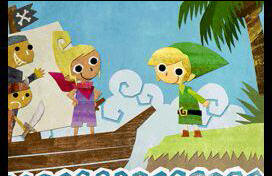
(And so, Peter Pan and The Lost Boys set sail for Never Never Land…wait. Wrong story)
So, you met up with Lineback after coming to his rescue in The Temple of the Ocean King, before grabbing the first sea chart. You ask him if he can escort you (after all, who else is going to steer the ship?) around the four seas as you search for the Ghost Ship. Of course, being the miserable little skinflint that he is, Lineback refuses. However, all it takes is a rumor about a treasure being on-board the Ghost Ship for this petty miser to have a change of heart.
[embed:http://www.youtube.com/watch?v=iNo1QvrhGvU ]
And with that, Link, Ciela and Lineback lift anchor and head out in search of the fair Princess Zelda, er ah, the energetic pirate captain Tetra. Eventually we’ll learn that the Ghost Ship is under the command of a rather nasty demon named Bellum, who is not only holding Tetra captive but also the Ocean King. Can this mismatched trio defeat this monster and restore peace to the Great Sea?
The story may not be as long or as drawn out as in other entries in the series (this is a handheld entry after all) but it is pretty well crafted (albeit simple) story with some pretty memorable characters (if not wacky), especially Lineback (I wish he was in every Zelda game). Not too mention the fact that I really do like the buddy dynamic between the main protagonists. I know the whole mismatched band of heroes is an old cliche but the reason it is an old cliche is because it can work very well when done right and this is one of those instances. Especially, when you prepare to explore an island and Lineback comes up with a list of excuses as to why he can’t join Link and Ciela. Link’s silent reaction as the other two butt heads can be pretty funny to watch. Lineback even gets his own little side-story, well sort of, but we’ll get to that later.
Oh and no. Ciela isn’t even close to being as annoying as Navi (Ocarina of Time). I would even go, as far as to say that she is a pretty likable character. Even though, she’ll let out the occasional, “Hey!”
The game’s music is pretty damn good but I don’t know how else to describe it other than saying that it’s a standard Zelda soundtrack. OK. I realize that is a bit of cop-out, so I’ll be a little more specific. Like a typical Zelda game, it has a mix of classic Zelda songs and new tracks that seem to have an orchestrated arrangement but this time they are altered slightly to sound more electronic, like what would have happened to the music in an old school game. However, a DS cartridge is more than capable of handling sophisticated musical arrangements (Final Fantasy III is a good example), so why did the composers decide to go this route? Well, the electronic altering also makes the songs sound a little bit lighter in tone than they would have sounded if they were left in their original format. I would imagine that this was done to match-up with the cartoonish/goofier art style, which it does and beautifully I might add. Especially in the few slapstick scenes that are scattered throughout the story. It should also be said that the sound effects are great and that the groans and sighs that are used as a replacement for voice acting are cute and are used very well to helps convene the measure of surprise/joy/grief felt by the characters during relevant plot points. Well, actually Link groans a lot in battle, which any of use would likely do if were fending off massive, sword-wielding fishmen, giant sand worms, evil spirits and perhaps the most dangerous of all, gangs of angry chickens. Oddly enough it doesn’t feel overly used or annoying. I guess the music drowns some of it out a little.
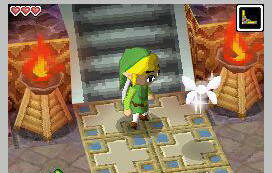
(Hey Lis…. "Shut Up! I heard you the first time.")
Graphically, Phantom Hourglass looks great. Being a sequel to Wind Waker, Phantom Hourglass shares its unique cartoony/cel shaded art style. Before moving on, I’ll have to elaborate on point I made earlier about some Zelda fans hating Wind Waker. You see, a lot of the hate seems to be targeted at the art style with a lot of fans thinking that it looks way too kid-friendly, because for some reason they think that the Zelda franchise is too dark and mature for that…..riiiiggghhht.
Warning! Warning! Mini-rant incoming:
Granted the Zelda franchise has it deeper/darker moments but at it’s core The Legend of Zelda is a saga that is meant to appeal to all ages. Besides, just because some thing looks all bright and colorful on the surface, doesn’t mean that it lacks a certain depth or substance that adults look for in a story (think Pixar). On the flip side of that argument, just because a story has a slightly darker look or tone, doesn’t mean that it isn’t accessible/relate-able for/to a younger audience (think Batman: The Animated series or Don Bluth’s work before he went nuts and created Rock a Doodle).
[embed:http://www.youtube.com/watch?v=oQSuJ6EFlQI ]
The Legend of Zelda has pretty much always fallen into both categories, since most games in the series have a different look and feel to set them apart (just one of the few advantages of having a time-line/continuity that isn’t set in stone) and you know what? It’s done that way on purpose to cater to hardcore fans who grew up with (remember you were kids once to) with the series and to new fans (many of which are children) who want to make a fresh start without having to worry about the amount of back-story that a more firmly set continuity would bring to it. Sorry to take up so much time with this but I have a feeling that many of the people who complained about Wind Waker (although the look is understandably not for everyone, so I apologize to the non-snobs who don’t care for the art style) are just gaming snobs, who don’t want younger gamers anywhere near favorite franchise. People like that just get on my nerves; not too mention their whole argument is short sighted. After all, if child gamers play and enjoy Wind Waker, than they would likely seek out other entries in the Zelda franchise, which can only help the series growth. Not too mention, that it might make them seek out more “core” games and help with the evolution of their own tastes and preferences. Just because someone is a kid, that doesn’t mean they can’t truly appreciate a great game.
Rant over.
Sorry if I got a little carried away there and I will even take this time to admit that although I really do like the look of Wind Waker, the color scheme could be a bit too bright at times (but it’s gorgeous other than that). While Phantom Hourglass follows this same art style, it’s toned down because the DS doesn’t exactly have the same graphical capabilities as a Game Cube but personally, I think the slight lack in color actually works in the games favor but that’s just my own personal preference. But that isn’t to say that Phantom Hourglass isn’t as lively and charming as Wind Waker because it is, in fact I think the cel shaded character models look better without the blinding colors.
Speaking of the character designs, being an animation lover, I absolutely love the cartoony look of the residents of the Great Sea and how not one character looks like any of the others. The enemy designs are also creative, with the usual wide verity of monsters. The bosses look especially great and range from a giant two-headed dragon, to a giant wooden robot, to a fire wizard, to a giant crab. That’s a lot of giants.
Although this giant is mysteriously absent:

(Yes master!)
I also like how both screens are implemented. During the basic gameplay, your map will be on the top screen, while the actual gameplay is visible on the touch screen. However, this is not the case during some of the boss fights. Link is shown on the bottom screen, while the boss is shown at the top screen. I like this for two reasons. One is the fact that having to keep your eyes on both screens is a nice way to keep the players on their toes and the other is that it really is a nice way to add in more of the background, which makes it feel as if you are not playing the game on a smaller handheld screen. Some of the cutscenes use both screens as well and to good effect.
[embed:http://www.youtube.com/watch?v=FO5J3So46z4&feature=related ]
With Phantom Hourglass being the first Zelda game on the Nintendo DS, the developers decided to do something just a little bit different and by that I mean they decided to implement the handheld’s touch screen and by that I mean the entirety of the gameplay relies on touch controls. Well, that isn’t entirely true. I mean, you still need to press the Start button to pause the game and the microphone is used for a few puzzles and at least one moment that requires you to yell in it like some kind of crazy person.
With that said, let’s start with the touch controls, shall we? Some of you might be asking, “how can Link even move without the use of the D-Pad?” The answer is quite simple really, all you have to do is lightly drag the stylus in the direction that you wish for Link to go and like the obedient little soldier that he is, he will follow. The faster you move the stylus, the faster his pace will be but it should be said that if your movements are little on the jerky side, he’ll trip over his own two feet.
Attacking is also quite simple. To strike an opponent, all you have to do is tap it with the stylus and Link will drop the hammer, er ah sword. You can also perform a slash attack by drawing lines across enemies and a spin attack by drawing a circle around Link. Just be sure to not abuse the spin attack or he will get dizzy.
Saving your progress, using healing potions, checking your inventory/map and selecting items (which are mostly secondary weapons) can all be done through the Menus that can be accessed by pressing the buttons at the bottom of the touch screen. Although it should be said that when you select an item, you have to tap the item icon on the right hand corner to have Link draw it out. Link can not use his sword when he has another item drawn. To swap the item for the sword, just tap the item icon a second time.
It should also be noted that any time you have your map selected, you can draw on it with the stylus. This comes in handy, since a few of the game’s puzzles are pattern based, like say having to operate a select number of windmills (by blowing on them via the DS mic), in a certain order. Thanks to the drawing feature, you can check off the areas you need to go and which ones you have already visited. This is also useful when you are given clues at certain points in the game that you will have to use later one, like when you have to draw a symbol on a door in order to get it open. God, drawing those three conjoined triforces sure was annoying.
What’s that? You’re left-handed you say? Your not comfortable with using the stylus as the main method of control you say? Well, there is no need to worry about dominant hands here. You can set the game to a right or left-handed preference. So, no need to try and find a left handed DS down at the Leftorium.
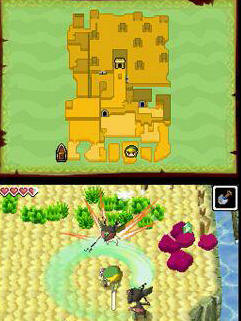
(Avast ye nave!)
So, if you haven’t guessed it by now, Phantom Hourglass plays just like most other Zelda games in the sense that you have to search through different areas (in this case Islands) for items and treasures that are instrumental in finding the Ghost Ship, while hacking and slashing monsters and solving puzzles on the way to each destination, which is pretty much always a temple.
[embed:http://www.youtube.com/watch?v=pGM-Q4Q63TQ&feature=related ]
Speaking of temples, these areas sport the same dungeon crawling aspects you would see in most other Zelda games. Of course you still have to hack and slash your way through monsters like you do on the outside but of course the temples focus more attention on the puzzle solving and exploration aspect of the gameplay. Although, your items (like your bow and arrows, hammer, hook shot, bombs, boomerang, etc) are going to be used more often in these instances to not only solve puzzles but to find hidden areas and take care of stronger enemies. You’ll also have more obstacles to avoid and beware of any and all traps that are scattered throughout each one.
Oh and of course, at the end of every temple, you’ll come across a boss that you must defeat in order gain the treasure you were searching for, as well as an addition heart container (extra health in other words) and some sand for the Phantom Hourglass.
Ah yes, the Phantom Hourglass. Now this is where things begin to deviate from the Zelda norm a little bit. Before your search for the second sea chart begins, Ciela’s grandfather tells you that you must return to the Temple of the Ocean King to further explore its confines. However, as you will learn after your first visit to the temple, you’ll notice that it has a way of draining the life force of anyone foolhardy enough to enter.
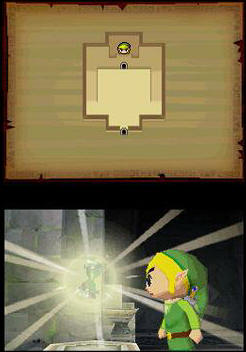
(Like sands through the hourglass, these are the days of our lives)
But fear not, for this is where the Phantom Hourglass comes in. Once the old man gives it to you, he’ll explain that it has the power to protect you from the temple’s dark energy. However, it will only last until sands in the hourglass run out (time limit is shown on the left-hand side of the screen). Once they do, you’re health will be quickly drained until you are killed. This is why you can find some extra grains of sand throughout the game, like I said before you get some extra sands after defeating bosses but you can also find some in few treasure chests that are hidden away beneath the Great Sea (more on that later) and even in the Temple of the Ocean King. Although the grains in the temple only give you about an extra 15 to 30 seconds but hey, you’ll take anything you can get. Yup. That Phantom Hourglass sure comes in handy….because you’ll be visiting that temple. A lot. OK, five times (four sea chart searches and the first fight with Bellum). But it can get pretty damn repetitive. Sure, the temple gets more elaborate with each entry and those damn Phantom Knights get more powerful each time but having to constantly back track is kind of sucky. But hey, at least you can teleport to the midway point once you’ve reached it.
Yay! He said, sort of sarcastically.
Seriously though. Why not divide the Sea Charts among different temples that are located throughout the seas? Why not just use the Ocean King Temple for the first sea chart and the showdown with Bellum?
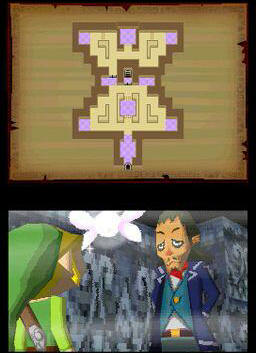
(Lineback tells Link that he better enjoy this temple, because he'll be seeing a lot of it)
Here are five tips to help you survive the Temple of the Ocean King:
1.) Be sure to step on the glowing squares. Not only will the Phantom Knights not see you when you are standing on them but time will also freeze.
2.) Use the boomerang to kill those weird sonar things from a distance.
3.) Look carefully for short cuts.
4.) Grim Reapers are similar to Boos.
5.) You can stun Phantom Knights by shooting them in the back with arrows
[embed:http://www.youtube.com/watch?v=7plKQ4T0980&feature=related ]
Now that I’ve rambled on about combat, puzzle solving, and dungeon crawling, let’s dig into Link’s high seas exploits shall we?
Oh wait a second, I guess I should tell you a little bit about the boat first, eh? Lineback’s boat is a customizable vessel that can be (as the kids say) tricked out with a variety of different parts that can either be purchased in shops or found during your journey. You can be creative and use a wider variety of parts to build something that’s really far out or you can be more on the conservative side and stick to using matching parts. It should also be said that using matching parts can increase the boats life bar, so it pays to be a little more right wing…. in this instance. ;)
Sailing from one destination to another is actually rather simple. When on the boat, all you have to do is select the sea chart from the menu screen. Once this happens, the sea chart will appear on the touch screen, which you will then draw a line from where you are on the map to the destination of your choosing. After that, the ship will move on its merry way.
Sea voyages can feel rather long at points but that doesn’t mean that the chaps over at Nintendo didn’t throw in any curve balls to spice things up a bit. For instance, enemies (like sharks, pirates, flying eyeballs, etc) will pop up occasionally to try and sink you, all of which you can easily (except for those damn sharks) blast away with your canon by simply tapping them with your stylus.
Speaking of enemies, you will also engage in a few high seas boss fights (flying multiple-eyed whale thing, giant plant monster and the Ghost Ship). All you have to do in these instances is observe the boss’ weak points and blast away. You will also face the occasional snare obstacle that you will have to jump over by tapping the arrow icon at the bottom of the screen.
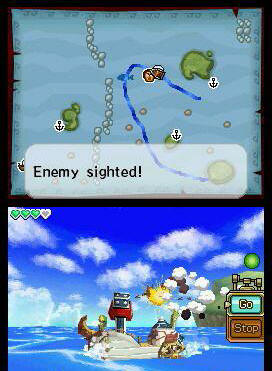
(Fire the cannon!)
Oh and while on I’m the subject of sailing related combat. This seems like a good time to bring up Lineback’s little sub-plot (which Link finds himself caught in the middle of). During your search of the Ghost Ship, you will have a good share of encounters with a pirate named Jolene, who has a grudge against Lineback (I’m sure if you’ve guessed why, you’d probably be correct). If her ship gets close enough to yours, she will declare war and begin to fire missiles, as she steers straight into your ship. When this happens, you have two options. A.) You can change course and attempt an escape or B.) You charge back at her ship and let her board you. Either way, she isn’t going to leave you alone until she boards your ship and fights you a few times (as Lineback hides inside of a crate), so you may as well just fight her and get it over with. I like the story behind it since it gives the player a nice look into Lineback’s past but she constantly picks the worse possible time to attack. She always seems to harass you right before you reach your destination, you know, after all of that time you spent searching for it? The fight doesn’t even change. She is just as easy to defeat every single time. But at least Lineback will give you a few rupees for your troubles. Gerrrrr.
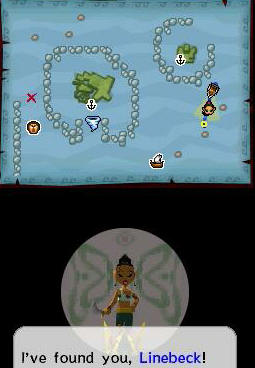
(Ah come on! Why can't you leave me alone you horrid she devil!)
Does sailing the Great Sea offer anything else besides combat? Well, you can search the sea’s floor for treasure using the ship’s salvage arm. To do this, simply choose a spot to stop and select the salvage arm from the menu. Once you do this, the salvage arm will be plunged into the water and the gameplay will then shift focus to a mini-game where you take control of the arm. You will be using the stylus to move the arm left and right, as it inches its way down to the treasure. You will then have to move the arm as it inches its way back up to the ship. Oh and if things are progressing a little too slow for you, you can also pull the lever at the bottom of the screen to increase its speed. However, this isn’t quite as easy as it sounds. There are living mines that you will have to dodge, and steep surfaces, you’ll have to squeeze through in order to claim your booty. If you use up all of the arm’s hearts, not only will it drop the treasure but it will also break and you’ll have to pay to get it repaired. This game is a fun and perfectly controlled little diversion and can even offer up some useful items like extra sand for the Phantom Hourglass and some new parts for your ship.
Besides looking for treasure, you can also kill time by looking for uncharted islands, where you can explore new areas, find some more treasure and even play the odd mini-game.
[embed:http://www.youtube.com/watch?v=UQTzf_hA3wY&feature=related ]
As far as extra content is concerned, there is a multi-player Battle Mode but since it doesn’t use the DS Download feature, I couldn’t sample it. From what I can tell, it is a two-player game in which two Links are gathering Tiforces, with the one to gather the most being the winner. You can also play as Phantoms who are trying to stop Link from getting the Triforces, the only catch is that you can’t touch or see him when he is in the safe zone. This sounds like a pretty neat little game. Too bad I didn’t get to try it out.
You can also use the WiFi feature to exchange items with other players, as long as you have their Friend Code that is.
Since I didn’t have much to say about the extra features, I guess I could talk about some of the mini-games you will comes across, like the archery game, which is basically a test to see if you can hit a select number of targets before the time runs out. If you can beat the record, you’ll a nice little rupee pay day. There is also a sailing mini-game, which has you circling around a course and blasting at targets, with the goal being to beat the previous high-score before reaching the finish line. But don’t worry. Even if you don’t get the high score, you’ll still get a prize, even if it isn’t necessarily a good one. One other mini-game that comes to mind is the Goron Roll game in which you take control of a member of the Goron Tribe and roll him through a race track with the goal being to smash all of the shiny objects (I think their crystals or something) on his way to the finish line and to do it in the fastest time. However, you can still get a (slightly lamer) prize even if you don’t bet the clock. Like the other two mini-games and the salvage games, the Goron Roll is a nice and perfectly controllable distraction from the main quest, that and it’s always nice to control another character.
Oh yeah, near the two-thirds mark of the game, you will be given a fishing pole by an old traveler (after you catch a mermaid for him). With this pole you will be able to catch any fish that are swimming in plain sight as you are sailing along. All you have to do is get close to them and then select the pole from your menu. The gameplay will then shift focus to a fun fishing mini-game, in which you will have use your stylus to tug on and reel in the line at the right time. There are a total of six varieties of fish to catch, although some are pretty rare.
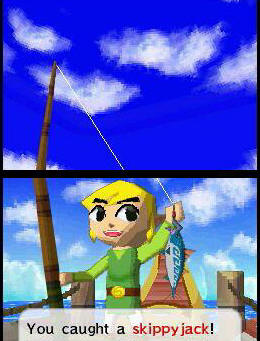
(Na Na Na Na Fishing! Na Na Na Na Fishing! Fishing! Fishing! Fishing!)
[embed:http://www.youtube.com/watch?v=YTGTVG3Wz7M&feature=related ]
Well, it seems that the grains of sand in this reviewer’s hourglass have just about reached the bottom and on that note, he must gather his thoughts and reach a reasonable conclusion. So, what can be said about Phantom Hourglass?
Well, it’s unique characters, charming art style, whimsical music and flawless gameplay make it a worthy addition to any DS library and a must have for any Legend of Zelda fan.
However, thanks to some repetitive moments of gameplay and sea voyages that even with fun distractions, monster/pirate attacks and a few hidden short cuts, can still feel as if they are dragging, Phantom Hourglass comes up just a tad bit short of “legendary” status. In my opinion.
Final Score: 8/10
….. ….. ….. ….. …..
I’m going to get flamed for this aren’t I?
